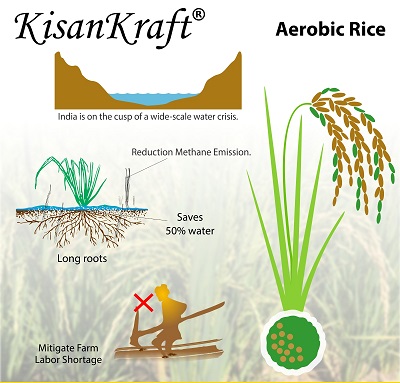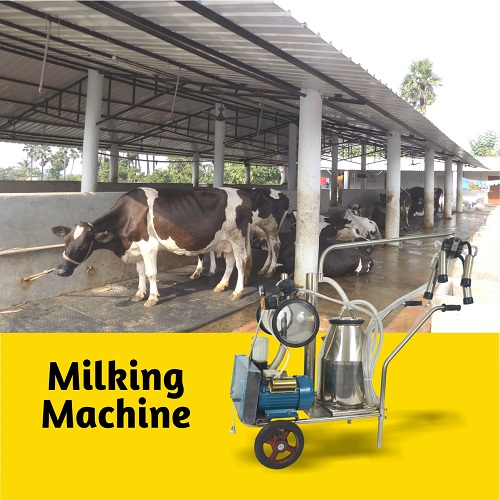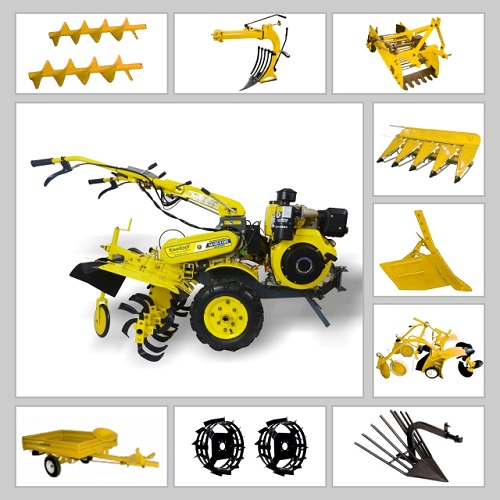KisanKraft Conducts Demonstrations on Aerobic Rice
KisanKraft, a manufacturer of quality agricultural equipment – now venturing in to seed industry, has successfully conducted a series of demonstrations pertaining to aerobic rice cultivation across the country. Aerobic rice is a new variety of seed combined with simpler system of growing rice which can be grown without standing water, just like any other dry land crops.
Field demonstrations on aerobic rice were conducted in Chhattisgarh, Gujarat, Haryana, Karnataka, Madhya Pradesh, Maharashtra, Meghalaya, Telangana, Uttar Pradesh and Uttarakhand. These demonstrations were conducted by the scientists of KisanKraft’s R&D division, with the aim to educate farmers on the advantages of aerobic rice technology. Dr. Samarendra Sahoo, GM – Agronomy, KisanKraft Limited said “These demonstrations were made considering the numerous advantages of aerobic rice and water scarcity in future years”
A major advantage of aerobic rice is that it uses 50% less water than that required for traditional wetland paddy cultivation. As against 5,000 litres of water required to produce one kg of conventional rice, aerobic rice requires between 2,000-2,500 litres. With this variety, there is no need of transplantation and puddling. Further, the amount of fertilizer and pesticides required are reduced, which results in a reduction of the labor costs and in turn enhancing the farm income.
Aerobic rice is eco-friendly as there is no or very less emission of greenhouse gases such as methane. Aerobic rice can be grown as an intercrop of mixed crop with pulses, oil seeds or vegetables. This could also be grown in low rainfall areas.
Speaking at the Aerobic Rice crop demonstration at his own field in Mahasamund (CG), Mr. Sanjay Chandrakar said “Earlier I was not cultivating rice as we had limited water availability in the fields. When the KisanKraft scientists introduced me to Aerobic Rice and how it can be cultivated without standing water and dry direct sowing, I had my doubts about the seeds and its germination. As of now, I have harvested 10 quintals of rice in just half an acre with only one irrigation, that too right after sowing. I am confident that now my family can eat rice grown in our own field every year”.
Mr. Rohit Kumar Joshi, who visited the field was very happy to see that rice can be grown in dry farming practices, saying, “I am really surprised and happy to see that rice can be grown in such dry conditions. This means that rice can now be grown in areas where wheat or maize are being grown. Many famers in our region have stopped growing rice because of water scarcity. Now I am sure that they can also grow rice with ease.”
Mr. Ramashankar Verma of Itarsi (MP) said “I have grown aerobic rice by only using rainfall effectively. Irrigation has only been done three times during the entire crop duration. I was really surprised to learn that there is no need of puddling and nursery to grow rice. Previously, seeing the feet of farm laborers coming out of the puddled field, after transplanting, was really painful. There were wounds and their legs would be swollen etc. But now I am happy that there is no need of such activities and the injuries resulting from them are nullified.”
Mr. Rajkumar Chawhaniya a farmer from the neighborhood said “Aerobic rice has always captured my interest and I have been frequently following up on all the activities in this method of farming. I am really impressed with this technology and I will grow aerobic rice in my field from next year”.
“I was really amazed to see that I can easily grow aerobic rice in my mango orchard. This will not only give me rice but weed management in my mango orchard will be very easy, which will keep the soil healthy” says Mr. Kander Patel, a farmer from Navsari (GJ).
Pavan Kumar from Yamuna Nagar (HR) said “There was no insect or disease attack when cultivating Aerobic Rice in my field and hence, I did not need to use any chemicals and pesticides. I am really happy that my family now can consume healthy, chemical free and nutritious rice in their everyday meals”
Mr Gurudev Singh from Sudiyarpur said “Since there is no requirement of nursery or puddling, there is no need of expensive operations like LASER levelling which we normally do for wetland rice. This makes rice cultivation easier, better and efficient.”
Mr. Sumit Gangwar from Manjhana village of Farrukhabad district (UP) was happy that this method of rice cultivation saves lot of money required for cultivation. He said “Since you don’t have to flood the field, it saves money for irrigation. And since there is no standing water, there was no disease or insect in the crop. I have not sprayed any chemicals and that as saved a lot of money. When the cost to grow the crop decreases, it obviously increases my profit, and I am happy for that.”
Mr Santhosh Shinde from Rajuri village of Solapur district (MH) said “I learnt that rice can be directly sown in the main field using seed drills. Untill now, I used to sow around 20-25kg seeds per acre for wetland paddy. Now I just need 6-8 kg seeds per acre”
Mr. Kisan Bobade another farmer from Rajuri said “Using machines for intercultivation or weeding was easy as the crop was sown using seed drill. This crop can be cultivated mostly using small machines, which is very helpful, especially to small and marginal farmers, as getting laborers is very difficult and expensive these days”.
Mallikarjun Desai from Sindhanur (KA) said “I used to depend on water canals for growing rice under flooded conditions and when water availability became a problem, I tried to explore many options like SRI method, which reduces water requirement to certain extent. Recently I was made aware about aerobic rice. This is a boon to farmers like me, which reduces the water requirement to an extent of 50%. Now I can grow rice by utilizing rain as well as borewell for protective irrigation. I have recommended that my friends, relatives and neighbors go in on this method of rice cultivation”.
Aerobic rice is gaining popularity in the regions where demonstrations are being held. KisanKraft and its scientists have taken it upon themselves that they will further spread the aerobic rice technology to all parts of the country. It can be seen that increasing the area under aerobic rice is helpful to the farmers as it reduces the water requirement and increases the farm income. Consumers are also benefited by the availability of healthy food which is not laden with pesticides and the nation is being helped to achieve food and nutritional security in a sustained way.





